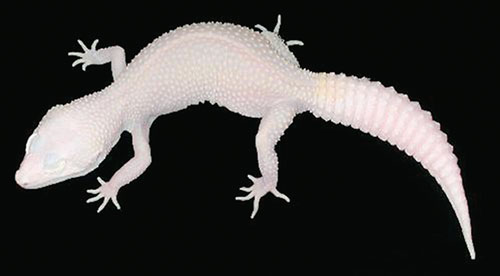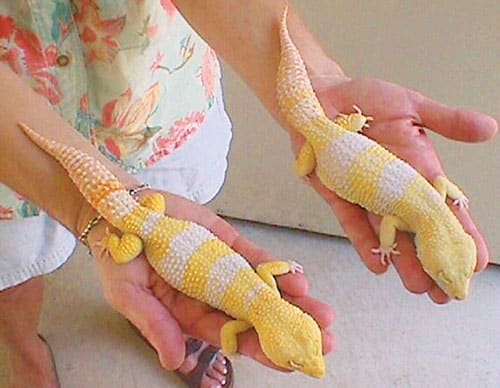Learn to breed leopard geckos from Ron Tremper.
 |
The leopard gecko (Eublepharis macularius) is native to the arid regions of Pakistan and India. Male leopard geckos reach a size of 10 to 12 inches long, and female leopard geckos can measure from 7 to 10 inches long. Leopard geckos are known to live more than 20 years. Due to the beautiful variety of captive-bred colors and patterns, leopard geckos have become one of the most popular lizard species kept worldwide.

Ron Tremper
The author was a pioneer in producing captive-bred albino leopard gecko hatchlings.
Leopard Habitat
A 40 to 50 gallon enclosure can house a male and female leopard gecko for their entire lives from hatchling to adult. Caging should be at least 1 foot tall, and have a secure screen top that will support a light fixture and keep bothersome cats from dining on your pet. Live or artificial plants can be added for decoration.
Newspaper, pea gravel, artificial turf, flat stones or no floor covering are good substrate choices for leopard geckos. Sand or fine-particle products on the cage floor can cause intestinal impaction if consumed by young or debilitated geckos.

Ron Tremper
All leopard geckos, including this diablo blanco morph, are active at night and do not need to bask under UVB lighting.
A hide box measuring 6 to 7 inches in diameter filled with moist peat moss or vermiculite is required, so your leopard can shed its skin and lay eggs properly.
The ideal temperature in the hide box is 86 to 90 degrees Fahrenheit at all times. This is a leopard gecko’s hotspot. The ambient air temperature should be at least 73 degrees. An undertank heating pad or heat tape is the best way to provide the proper hotspot temperature. Avoid heat rocks because they tend to become too hot and might burn your pet gecko.
A simple 25-watt light placed on the screen top can provide daylight. Keep it on for 12 hours a day. Because leopard geckos are active at night, they do not need to bask under UVB lighting.
Feed to Breed
Feed breeding leopard geckos crickets at least every other day, or keep a dish of mealworms (Tenebrio molitor) in the enclosure at all times. Insects should be no longer than the leopard gecko’s head and no thicker than half its width. Whether you’re using crickets or mealworms, it is essential that feeder insects be given a balanced diet. Gut load insects with chick or hog mash for 24 to 48 hours before feeding them to your geckos.
It is important that you offer your leopard geckos extra calcium and vitamin D3. Instead of dusting feeder insects, place a jar lid filled with the supplement in the corner of the cage so the leopard geckos can decide how much they consume.
Use a shallow, sturdy water dish measuring 3 to 6 inches in diameter to keep fresh water available at all times.
Breeding Basics
Typically leopard gecko females are not sexually mature until they weigh 45 grams and reach 9 to 10 months of age.
North of the equator, leopard geckos experience a breeding season running from January to September. Individuals hatched late in the year may not start laying eggs until April of the following season. While we do cool down females prior to breeding, never cool down first-year females because they are still growing. With our other females, we stop feeding 10 days before cooling, then keep them at 74 to 78 degrees Fahrenheit with water present 24/7 for six to eight weeks.

Ron Tremper
Geckos such as this raptor morph require a hide box measuring 6 to 7 inches in diameter.
When introducing a female leopard gecko to a male leopard gecko, the first thing you may hear is the male going through his tail-vibration routine, which sounds like a very fast rattle. A receptive female stands perfectly still while the male grasps her neck skin in his mouth and engages in copulation. A male restraining a female in this way is normal. A successful mating takes only two to three minutes from start to finish. Remove the female leopard gecko soon afterward.
Egg Laying
Leopard gecko females lay eggs 16 to 22 days after copulation. Once a breeding season begins, you can expect female leopard geckos to lay a clutch every 15 to 22 days over a four- to five-month period. Female leopard geckos may lay one or two eggs for the first clutch of their lives, resulting in eight to 10 eggs for their first breeding year. Leopard geckos can produce 80 to 100 eggs over a lifetime.

Ron Tremper
These two super giant albinos weigh 150 grams each. Their size resulted from a random mutation.
Provide an egg-laying box at least 6 to 7 inches in diameter and 4 inches tall. For cages housing three to five females, a plastic shoebox is ideal. All will lay their eggs in that same spot. Make a 2-inch-diameter hole in the box lid, so the geckos can get in and out of the box. Fill the egg-laying box with peat moss, vermiculite or Bed-A-Beast litter, which must be kept moist — it should feel like fresh earth — but not too wet.
Poor nutrition, not male sterility, is the leading cause of infertile eggs. Another cause of infertility occurs when virgin female leopard geckos aren’t introduced to a male once they reach 45 to 55 grams, or when females have not been bred at least once a month.
Egg Incubation
The most common containers used for leopard gecko egg incubation are plastic deli cups or shoeboxes filled with 1 to 2 inches of vermiculite or perlite. Achieve proper moisture by mixing equal parts of incubation medium to water by weight, not volume. Slightly bury leopard gecko eggs, and space them at least a half-inch apart. Cover the egg box with a tight lid, and add five to 10 pushpin-sized air holes to the top.
If you see dents occurring in leopard gecko eggs during incubation, then your medium is too dry. If that happens, spray the inner sides of the egg container — not the eggs directly — four or fives times.
Incubation temperature determines a leopard gecko’s sex. If eggs are incubated at 80 degrees, then 100 percent of the hatchlings will be female. At temperatures around 87 degrees you basically get an equal number of male and female leopard geckos. At 90 degrees 98 percent of the hatchlings will be male. Temperature conditions below 74 degrees can be lethal.
If you need to control egg temperature, a number of simple incubators are available. Never place leopard gecko eggs in an incubator without substrate or moisture. They turn into raisins if you do. Eggs incubate 35 to 89 days depending upon the incubation temperature.
Hatchling Care
Until hatchling leopard geckos reach a length of 7 inches, they are best raised alone in a simple shoebox setup measuring 12 inches long, 6 inches wide and 4 inches tall. This cage is ideal because it offers close proximity to water, food, heat and shelter. A continuous temperature of 90 degrees under the hide box is optimum for juveniles. The cool end should be the same as the adult’s requirement: 73 degrees. Paper towels can serve as the floor covering.
Hatchling leopard geckos shed their skin and begin eating after the first three days of their lives. Regular 1-inch-long mealworms are the best offering for baby leopard geckos at this time. Place five to 10 mealworms in a jar lid every other day.
Leopard Gecko Care Sheet By Ron Tremper>>
Bonus Content Tremper Albinos>>



